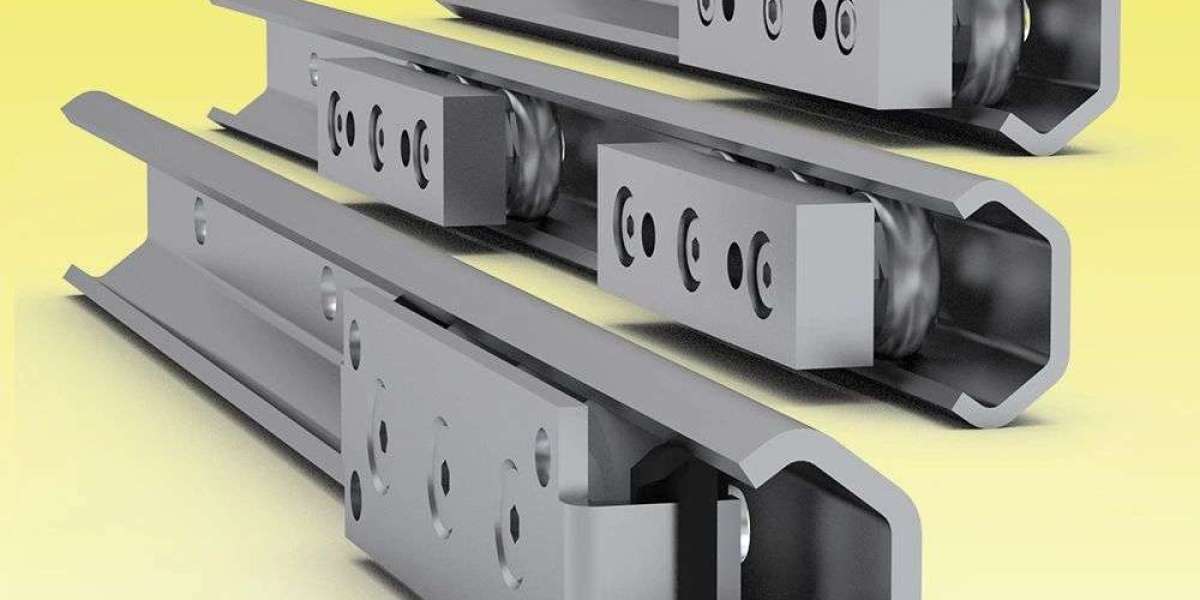What Are Linear Rail Bearings?
Linear rail bearings are precision-engineered components that facilitate smooth, low-friction linear motion along a fixed rail or track. They consist of two main parts:
- 1.
The Rail (Guide Rail): A rigid, precision-machined steel or stainless-steel rail with accurately ground raceways that guide the moving elements.
- 2.
The Bearing (Carriage/Block): The moving component that attaches to the load and contains recirculating rolling elements (balls or rollers) that glide along the rail’s raceways.
The interaction between the rail and bearing allows for controlled linear movement with minimal friction, high load capacity, and exceptional repeatability. Linear rail bearings are the backbone of many automated systems, ensuring precise positioning, smooth motion, and long-term reliability.
Key Advantages of Linear Rail Bearings
Compared to traditional sliding bearings or other linear motion solutions, linear rail bearings offer several superior characteristics:
- 1.
High Precision & Repeatability
Linear rail bearings can achieve tolerances as tight as ±0.001mm (micron-level accuracy), making them ideal for applications where precision is critical, such as CNC machining, semiconductor manufacturing, and optical alignment.
- 2.
High Load Capacity
These bearings are designed to support heavy loads (up to 200,000N or more) without compromising performance. They can handle both radial (perpendicular to the rail) and axial (along the rail) forces, making them versatile for various industrial applications.
- 3.
Low Friction & Smooth Motion
The rolling contact between the bearing’s balls/rollers and the rail’s raceways reduces friction by up to 90% compared to sliding bearings, enabling faster speeds, smoother motion, and longer component life.
- 4.
Rigidity & Stability
Linear rail bearings maintain their alignment even under heavy loads, ensuring stability and preventing deflection. This is crucial for high-precision tasks where even slight misalignment can lead to defects.
- 5.
Durability & Long Service Life
Made from hardened steel and often coated for corrosion resistance, linear rail bearings are built to withstand harsh industrial environments, heavy use, and frequent cycling with minimal maintenance.
Types of Linear Rail Bearings
Linear rail bearings come in various designs to suit different applications:
- 1.
Ball Rail Bearings (Most Common)
- •
Rolling Elements: Steel balls.
- •
Best For: General industrial automation, CNC machines, 3D printers.
- •
Advantages: Balanced performance, cost-effective, widely available.
- •
Load Capacity: Medium to high (up to 100,000N per rail).
- •
Precision: Good (±0.001-0.01 mm achievable).
- •
- 2.
Roller Rail Bearings (High Load Capacity)
- •
Rolling Elements: Cylindrical rollers.
- •
Best For: Heavy-duty machinery, industrial presses, large CNC routers.
- •
Advantages: Superior load capacity and rigidity.
- •
Load Capacity: Very high (up to 200,000N per rail).
- •
Precision: Excellent (±0.0005 mm achievable).
- •
- 3.
Miniature Linear Rail Bearings
- •
Best For: Medical devices, precision instruments, electronics assembly.
- •
Advantages: Compact size, high precision in confined spaces.
- •
Load Capacity: Low to medium (up to 1,000N).
- •
Precision: Exceptional (±0.0001 mm achievable).
- •
- 4.
Crossed Roller Rail Bearings (Ultra-High Precision)
- •
Rolling Elements: Alternating rollers at 90° angles.
- •
Best For: Semiconductor manufacturing, optical alignment, metrology.
- •
Advantages: Zero play, exceptional accuracy.
- •
Load Capacity: Medium (up to 15,000N).
- •
Precision: Outstanding (±0.00005 mm achievable).
- •
- 5.
Preloaded Linear Rail Bearings
- •
Best For: High-precision applications requiring zero backlash.
- •
Advantages: Enhanced rigidity, improved positioning accuracy.
- •
Implementation: Internal preload mechanisms (springs, shims).
- •
Precision: ±0.0001 mm or better achievable.
- •
Applications of Linear Rail Bearings
Linear rail bearings are used in a wide range of industries:
- 1.
CNC Machining & Manufacturing
- •
Applications: CNC mills, lathes, routers.
- •
Requirements: High precision, heavy load capacity.
- •
Solution: High-precision linear rail bearings.
- •
- 2.
3D Printing & Additive Manufacturing
- •
Applications: Print head movement, build platform positioning.
- •
Requirements: Smooth motion, moderate precision.
- •
Solution: Ball rail or miniature linear rail bearings.
- •
- 3.
Robotics & Automation
- •
Applications: Robotic arms, pick-and-place machines.
- •
Requirements: Precise, repeatable motion.
- •
Solution: Configurable linear rail systems.
- •
- 4.
Medical & Laboratory Equipment
- •
Applications: Surgical robots, diagnostic devices.
- •
Requirements: High precision, cleanliness.
- •
Solution: Stainless steel or miniature linear rail bearings.
- •
- 5.
Aerospace & Defense
- •
Applications: Satellite positioning, precision instrumentation.
- •
Requirements: Reliability in extreme conditions.
- •
Solution: Specialized linear rail bearings.
- •
Selection Criteria for Linear Rail Bearings
When choosing a linear rail bearing, consider:
- 1.
Load Requirements (Static & Dynamic)
- 2.
Precision & Repeatability Needs
- 3.
Speed & Acceleration Limits
- 4.
Environmental Conditions
- 5.
Mounting Space & Orientation
- 6.
Maintenance & Lubrication Requirements
Installation & Maintenance Best Practices
- •
Precision Alignment (Ensure rail and bearing are perfectly parallel).
- •
Proper Lubrication (Grease or oil, depending on speed).
- •
Regular Inspection (Check for wear or misalignment).
- •
Contamination Control (Keep rails clean).
Conclusion
Linear rail bearings are a cornerstone of modern precision engineering, offering unmatched performance in load capacity, accuracy, and durability. By understanding their design, types, and applications, engineers can select the right bearings for their needs. For more insights, visit YH Linear Newsor explore high-performance solutions at YH Linear.







